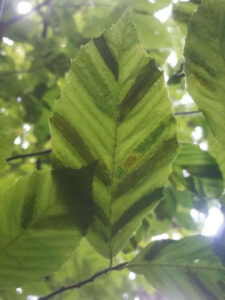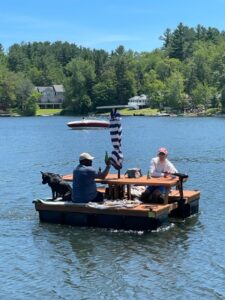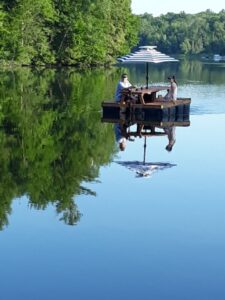Beech leaf disease (BLD) is a newly described disease, first identified in Ohio in 2012. The disease complex is associated with a foliar nematode species, Litylenchus crenatae. The disease causes damage to a tree’s leaves, leading to reduced vigor and can eventually lead to tree mortality
 According to MassWildlife there are still many unknowns about how the disease is spread, how new trees are infected, or how long it takes for symptoms to develop. However, they do know that American beech, European beech, and Oriental beech can be infected. Infected trees of all ages and in both urban and forested settings have been observed.
According to MassWildlife there are still many unknowns about how the disease is spread, how new trees are infected, or how long it takes for symptoms to develop. However, they do know that American beech, European beech, and Oriental beech can be infected. Infected trees of all ages and in both urban and forested settings have been observed.
BLD has quickly spread from its initial detection point in Ohio. Currently, it is being found in 10 US states and 1 Canadian Province. The first detection in Massachusetts was in June 2020 in the town of Plymouth. (Plymouth County). Symptomatic trees have since been found in all Massachusetts Counties. As of July 2022, BLD had been confirmed in 83 communities in Massachusetts.
The MA Department Conservation and Recreation (DCR) Forest Health Program is surveying beech trees across the state to determine the extent of the disease in Massachusetts. Based upon a map provided by DCR, it appears that the disease has been detected in several southern Berkshire towns this year.
BLD can be identified by the distinctive leaf symptoms it causes. Early BLD symptoms will include dark stripes between the veins on leaves. When looking up at the tree canopy from underneath, you might notice dark green bands on the underside of the leaves. As the disease progresses, leaves may become withered, curled, or develop a leathery texture. A heavily impacted tree may appear to have a thinner canopy or have sections of branch dieback.
Other insects and pathogens can also cause leaf damage on beech. However, this damage is usually easy to distinguish from BLD. Mites and aphids will feed on beech leaves and cause discoloration, but this is usually lighter in color than the leaf compared to BLD with has darker bands forming. Other insect or pathogen damage can cause leaves to look brownish and become more brittle, in comparison with BLD that will develop a more leathery texture as it withers and curls the leaves. Beech will also naturally hold onto leaves into the winter, if you see a beech with brown leaves still attached in the winter, this is normal.
If you think your beech tree might be infected with BLD, you are advised to report it to the DCR Forest Health Program by sending an email to Nicole.keleher@mass.gov or calling
(857)337-5173. Any details you are able to provide about the location, symptoms and severity of the disease, or any pictures of the tree will help them in their monitoring efforts of the progress of this disease in the Commonwealth.
We are not alone with this problem. The NY Department of Conservation (DEC) announced recently that BLD was identified in 35 counties in New York State to date. DEC began tracking BLD in 2018 after it was confirmed in Chautauqua County. Fourteen of the counties with BLD were confirmed in 2022, and more are likely to be identified.
“Many American beech trees are already heavily impacted by beech bark disease, but Beech Leaf Disease appears to be an even bigger threat,” said NY DEC Commissioner Basil Seggos. “The decline of beech in New York could have far-reaching consequences, including significant changes to the composition of our northern hardwood forests and the loss of a valuable food source for wildlife (deer, squirrels, turkeys, etc.). BLD affects all beech, so the impacts would also be felt in our urban forests where ornamental beech trees, including the popular copper beech cultivar, are widely used for landscaping and street trees.”
Much is still unknown about BLD, including how it spreads, but it can kill mature beech trees in six to 10 years and saplings in as little as two years. There is no known treatment for infected trees. It is unknown whether the Litylenchus crenatae nematode causes all of the damage, or if it is in association with another pathogen such as a virus, bacteria, or fungus.
At this time there are no specific recommendations for managing trees that are infected with BLD, however, NY DEC encourages the public to report potential BLD infections using iMapInvasives to help track the disease while research is ongoing.
It’s an alien ship! It’s Nessie! No wait, it’s a Picnic Table Boat!
One never knows what’s out there drifting in our Berkshire lakes. Look what drifted by our place on Ashmere Lake in Hinsdale last Sunday. It’s what they call a Picnic Table Boat. I thought I’ve seen it all, but this is something else. 
The boat is owned by Chad and Maureen Ezzell of Hinsdale. They purchased the boat from Maine Float, a company out of Winthrop, ME and it arrived on July 22.
It is powered by an electric motor, and if you run out of power, it has a solar panel on the top of the umbrella which recharges the battery. (Clean energy!). The battery has a USB port into which they plug in lights and a speaker for their sunset cruises. They can also plug in an iPad, cooler, etc. In addition to dining, they enjoy playing scrabble, taking video conference calls for work, and reading.
Aah, this is pure luxury. I can hear it now, Maureen, want to dine out tonight? Pass the potato salad please. Imagine, you can bring out a lantern at night and get out the cards while you’re fishing for bullheads.
This is ideal for folks who work at home. Bring along your iPad and conduct some business, entertain prospective clients and who knows, maybe you can write it off as a business expense.
When we saw it, the umbrella was down, because of the wind. It was the Ezzells’ first weekend on the boat and they didn’t want to chance it.
Fishing events for beginners coming to a lake near you
If you are new to fishing MassWildlife has a series of events which can help you learn how to fish. Adults and families who want to learn how to fish on their own can get instruction and have fun practicing skills including setting up a rod, baiting a hook, tying knots, casting, and identifying fish.
When you arrive, instructors will cover the fishing basics with the balance of the time spent fishing. To get the most out of the in-person class, participants are encouraged to watch MassWildlife’s online video tutorial before the day of the class. You will receive a link to the video with your confirmation email when you register. This class is designed for adults and families; participants ages 14 and younger must be accompanied by an adult.
The events are free, family friendly, and open to all skill levels. No fishing license is required. Bring your own fishing equipment or borrow theirs. Limited gear and bait will be provided. Unless it says it is required, event pre-registration is encouraged but optional.
The events being held in the Berkshires are as follows:
Tuesday, August 2 from 5:00 to 7:00 pm at Lakeway Drive near Onota Lake in Pittsfield; Thursday, August 4, from 5:00 to 7:00 pm at Pontoosuc lake parking, North Street, Pittsfield, and Saturday, August 6 from 10:00 am to 1:00 pm. at the Windsor Lake Park in North Adams.
License-to-Carry/FID Class
Mass State Police and NRA Certified Instructor Dan Peck will be holding a LTC/FID Class for residents and nonresidents on Sunday, August 21 at the Greylock Community Club, 548 State Road, North Adams, MA. The cost is $100 and starting time is 9:00 am
Everything will be provided in the class and all safety guidelines for Covid will be in place.
Seating is limited for this class and seating will be set up under covid guidelines at the time as well.
Anyone interested in signing up call Dan @ 413-663-4896 prior to class for info and registration.
